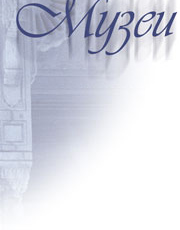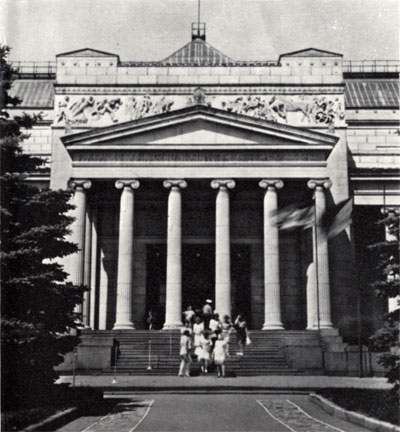
The Pushkin museum of fine arts in Moscow
The idea of a Moscow museum of fine arts was conceived in the eighteenth century. One of its advocates at the time was the first rector of the Moscow University, Alexei Argamakov. Later, in 1831, The Telescope magazine published a program for "an aesthetical museum." In 1857, when a chair of art history was begun at the Moscow University, its first professor, Karl Herz, again spoke about the necessity to open an art museum. But it was not until the early twentieth century that this idea began to be put into practice. The heart and soul of this project was Herz's successor, Professor Ivan Tsvetayev (1847—1913), who had made its realization his life work.

The Pushkin Museum of Fine Arts in Moscow
From the late eighteenth century the Moscow University had owned a collection of coins and medals known as the "Miinzkabinett." At the end of the nineteenth century it acquired a collection of plaster casts taken from antique sculptures. These two collections were to become the cornerstones of the future museum. Tsvetayev, who managed to enlist broad public support of the project, took active steps to ensure the growth of these collections and to begin the construction of a special museum building that was to house an exposition of casts representing masterpieces of European sculpture from antiquity to the Renaissance. From the very start the founders of the museum intended to enlarge its collections by introducing original works of art. In 1909, when the museum building was still under construction, (It was designed and built by architect Roman Klein (1858- 1924). His other important works in Moscow include the Middle Shopping Center (1902), now called the Central Department Stores, the cinema-theater Colosseum, the Borodino Bridge (1912), etc.) the museum received its first donation (from the diplomat Mikhail Shchokin) — eight paintings of the Italian school. In 1911 it received the famous collection of Egyptian antiquities which had formerly belonged to Vladimir Golenishchev. In 1912, after the building had been completed, the museum was formally inaugurated as the Emperor Alexander III Museum of Fine Arts affiliated to the Moscow University. (After the October Revolution it was called the Museum of Fine Arts. Its present name, the Pushkin Museum of Fine Arts, was given it in 1937 in commemoration of the centenary of Pushkin's death.)
The October Revolution ushered in a new stage in the life of the Museum. Among the first decrees of the Soviet State signed by Lenin in 1918 there was a decree on nationalization of the biggest private art collections. Subsequently they were handed over to state museums. A special decision taken in November, 1923, transformed the Museum of Fine Arts from a branch of the Moscow University into a self-governing institution. Its collections were to be enlarged by original works of art, especially by paintings.
Now the main concern of the Museum was organization of the picture gallery. Very soon, in January 1924, it received more than 300 canvases by Old Masters which had formerly belonged to the Rumiantsev Museum. (The Rumiantsev Museum (full name - the Moscow Public and Rumiantsev Museum) occupied the mansion which now is known as the old building of the АН-Union Lenin Library. It was established in 1862 to include the art collections and the library of Count N. Rumiantsev and some other collections, among them over two hundred paintings from the Hermitage. When in 1924 the Museum was closed, its picture gallery and other collections were distributed among several museums, while the library formed the basis of the Lenin Library which was opened in 1925.) They were followed by paintings and sculptures from the famous collection of Dmitry Shchukin which after the nationalization of 1918 had formed a museum of old Western European painting. Before the end of 1924 the Museum also received 180 pictures from the Moscow collection of G. Brocard, 174 canvases from the Hermitage, and a number of excellent works from Yusupov's and Shuvalov's collections, the Tretyakov Gallery and the State Museum Reserve. On November 10, 1924, the Museum opened the first two rooms of its new picture gallery which were devoted to Netherlandish, Dutch and Old German art and also included an exposition of French paintings transferred from Leningrad collections.
In 1925 the Museum continued its collecting activities on an even larger scale. The further transfers from the Hermitage, the Tretyakov Gallery and various Moscow collections were accompanied by new important additions from the Yusupov and Shuvalov collections which had contained many outstanding masterpieces. To mark the anniversary of the October Revolution, the Museum opened the rooms of Italian, Flemish and French painting, thus bringing to an end the first stage in organizing its picture gallery.
During this crucial period in the life of the Museum, its first director, Professor Nikolai Romanov (1867—1948), was directly responsible for the reorganization and development work. His closest assistants were Abram Efros (1888—1954), Curator of the picture gallery from 1928 and Professor Victor Lazarev (1897—1976) who in 1929 succeeded Efros as Curator of the picture gallery.
At the head of a group of young specialists who came to the Museum when its picture gallery was being organized, Romanov carried out tremendous work, exploring the state museum reserves, selecting pictures from a host of different collections, classifying them and undertaking their scientific investigation. It was a laborious task to unite in a harmonious whole the material of so many different collections. In some sections the gallery tended to become overburdened with works that did not differ considerably from one another, while in others there remained lacunas. Superfluous material was handed over to other museums, and at the same time no effort was spared in obtaining such works as were needed to make the exposition representative of all the links in the development of European art.
At the end of the first four years the character of the gallery was more or less defined. The sections of the Dutch and French schools, which included many first-rate works, were its best and most representative expositions. But even here there were some gaps that prevented a full historical survey of the artistic process. What the gallery was lacking were large, fundamental works. Such canvases could be obtained only from the Hermitage. The problem was studied by a special commission of experts which elaborated a plan for redistributing some of the museum treasures. It enabled the Hermitage to get some pictures from the Moscow Museum of Modern Western Art for its exposition of modern French painting. In turn, some of its Old Masters were to be handed over to the Museum of Fine Arts. As the result of this transfer, which took place in 1930, the Museum became the owner of seventy-three canvases which included masterpieces by Poussin, Rembrandt, Rubens, and Murillo. It considerably increased the importance of the gallery, making it one of the best European art depositories.
The first period in the formation of the gallery came to an end. In subsequent years the main source of its enlargement were purchases. They were made according to the decisions of the Museum Board of Experts, this work being directed by Professor Boris Vipper (1888—1967) who was then in charge of all the research activities in the Museum.
A very important addition was made to the gallery in 1948, when it received more than 200 pictures from the Museum of Modern Western Art. Most of the canvases transferred from this excellent collection were works by French painters—Manet, Monet, Pissarro, Renoir, Degas, Cezanne, Gauguin, Matisse. There were also some paintings by Van Gogh, Van Dongen, Miro and Picasso—the artists whose life and oeuvre were inseparable from French culture. This last transfer greatly enriched the French exposition and, in particular, extended its chronology: now it included many works of the twentieth century. With the new masterpieces the artistic importance of the whole gallery increased considerably. Now its general character, correlation of different national schools and historical periods took a definite shape. The time of radical changes apparently was over. Nevertheless, the gallery continued to grow.
Apart from regular acquisitions, the collection increased in size and value as a result of bequests and donations which came from the artists themselves (Leger, Guttuso, Manzu, Kent, and others) and from collectors in the Soviet Union and other countries.
The Museum organizes many temporary and loan exhibitions. Very often they are devoted to French art, as the Museum collection can provide any amount of material. Many French
paintings of the seventeenth to twentieth centuries were displayed in Moscow (1955) and Leningrad (1956). Large one-man exhibitions devoted to the art of Cezanne and Marquet were held in Moscow and Leningrad (1956, 1958 and 1959). French works of the 1850s to the 1890s were sent by different Soviet art museums to the Moscow exhibition of 1960. The centenary of Matisse was marked in 1969 by a large show of his work organized jointly with the Hermitage. The French school was widely represented in the display of new acquisitions mounted by the Museum in 1969, at the exhibition of Western European portraiture from the fifteenth to the early twentieth century (1972) and the exhibition of Impressionist painting in 1974.
French paintings from the Museum collection often appear in exhibition halls of Brussels, Montreal, London, Paris, Bordeaux, Prague, Tokyo, Vienna, Rotterdam, New York and many other cities of the world.
Several times during the year one can see new colors flying on flagstaffs in front of the Pushkin Museum. These are the national flags of the countries that have sent in their expositions or individual masterpieces of art.
The magnificent collection of the Moscow Museum makes an important contribution to the cultural exchanges between the Soviet Union and other countries of the world.
|
ПОИСК:
|
© MUSEUMS.ARTYX.RU, 2001-2021
При использовании материалов сайта активная ссылка обязательна:
http://museums.artyx.ru/ 'Музеи мира'
При использовании материалов сайта активная ссылка обязательна:
http://museums.artyx.ru/ 'Музеи мира'